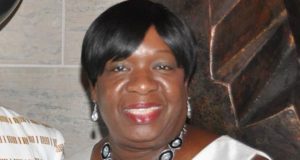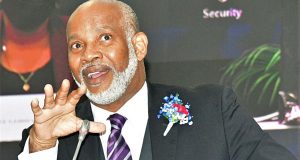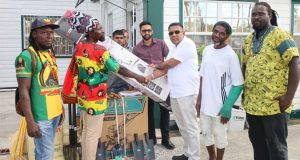ST. GEORGE’S, Grenada CMC – Thirty years after they were buried without a traditional funeral service, a head stone has been unveiled with the names of the 13 Grenadian soldiers who died during the United States led invasion of the island in 1983 to end the rule of the left-wing People’s Revolutionary Government (PRG).
The bodies of the soldiers, all members of the People’s Revolutionary Army (PRA), had mistakenly been sent to Cuba, but the authorities in Havana returned them to Grenada after conducting the necessary identifications.
“Before sending them back, the Cuba government paid them respect as soldiers who died defending Grenada and the revolution but when they arrived here, the interim government headed by Nicholas Brathwaite handed the body over to the undertaker who buried them at 3:00 am (local time) in the morning,” said Peggy Nesfield, who over the years have singlehandedly held an event on October 25 to mark the occasion that led to the downfall of the Maurice Bishop led government.
“They were soldiers who died defending the country and we should treat them with respect regardless of who was the government at the time,” said Ashley “Ram” Folkes, who this year spearheaded the project in which there is now a monument and a headstone where the soldiers were unceremoniously buried.
For the first time since the invasion, the National Celebrations Committee recognized the burial ground of the 13 soldiers and Prime Minister, Dr. Keith Mitchell, laid a wreath on behalf of the country while members of the October 19th and Martyrs Foundations paid their respect.
“It took us 30 years to have this, so I am hopeful that in the future we will not only have this headstone which is the site where they are buried but a monument in their honour, maybe in another place where it will be more visual,” said Folkes, who served in the PRA.
There is a monument on the compound of the Maurice Bishop International Airport to remember the US soldiers who died during the invasion and every year there is a special ceremony at the site and also at the US-owned St. George’s University, where a second monument is located.
Bishop’s government, which came to power in 1979 following the first ever other throw of an elected government in the English-speaking Caribbean, became involved in an internal battle with his then deputy, Bernard Coard, leading a faction that placed the then charismatic leader and his followers under house arrest.
United States invaded the island to restore democratic rule and Coard and several of his followers were later convicted of the murder of Bishop and other ministers. However, they were freed several years ago after the London-based Privy Council, the island’s highest court, ordered a re-sentencing of those convicted.
 Pride News Canada's Leader In African Canadian & Caribbean News, Views & Lifestyle
Pride News Canada's Leader In African Canadian & Caribbean News, Views & Lifestyle




